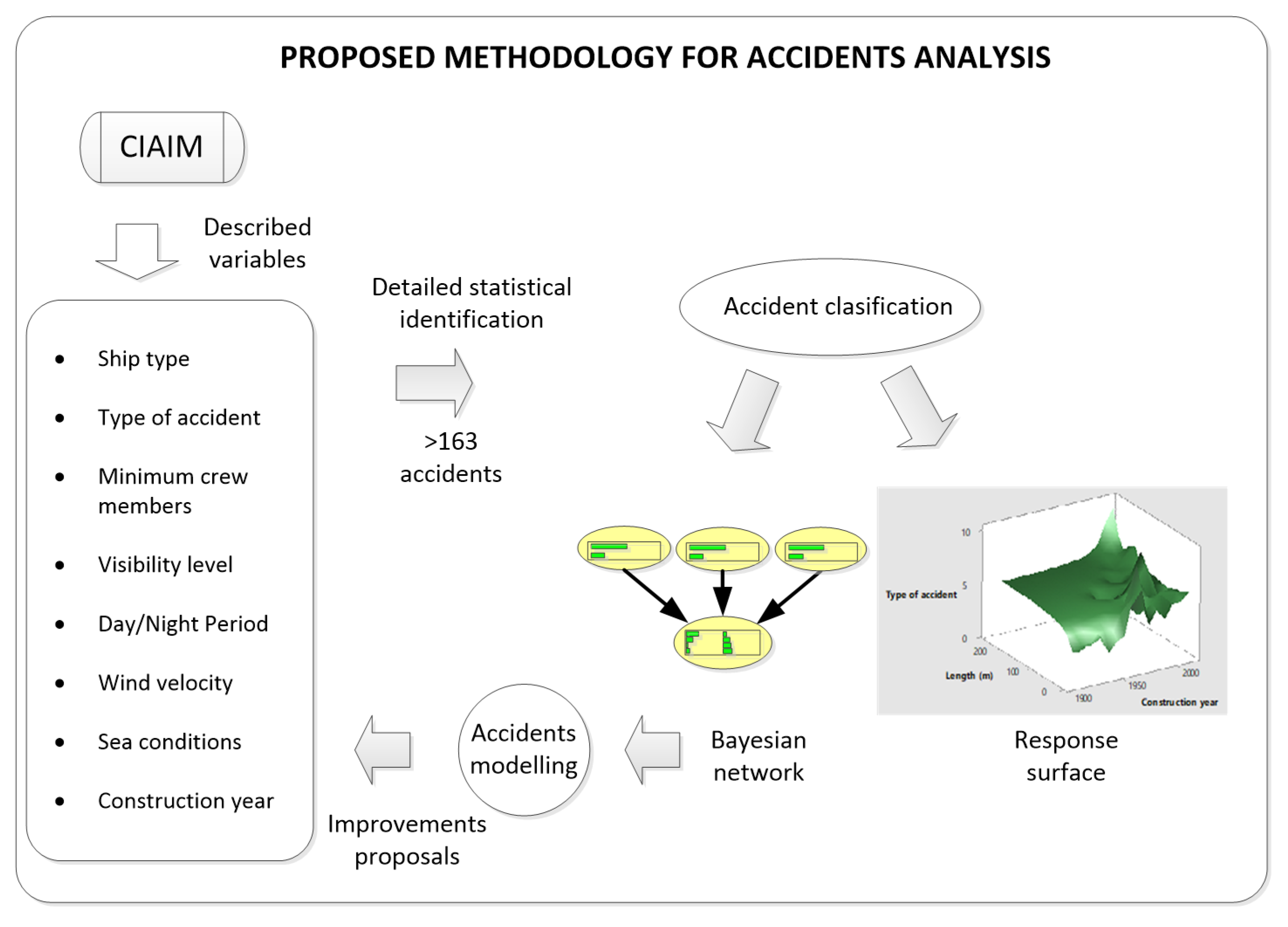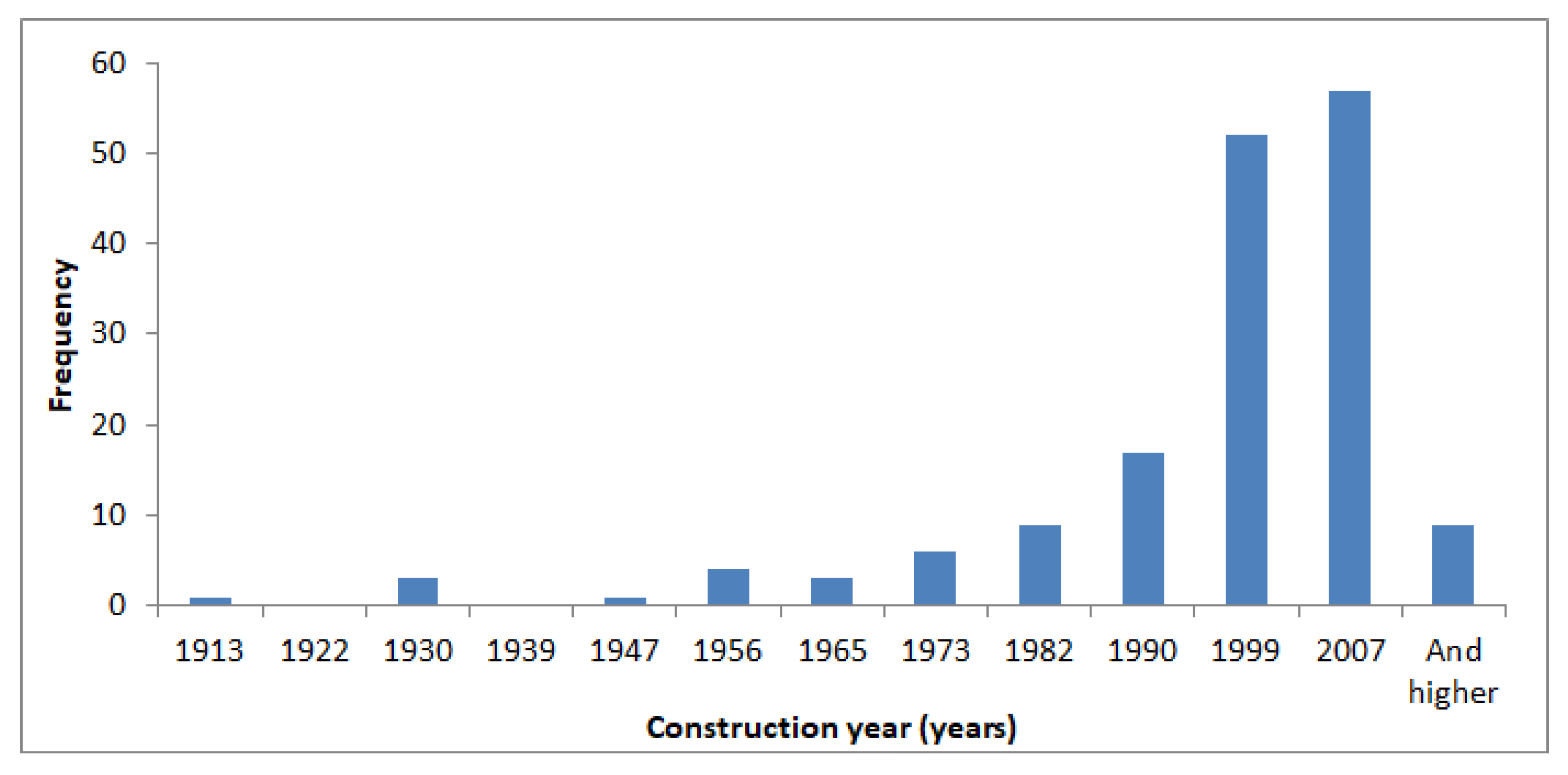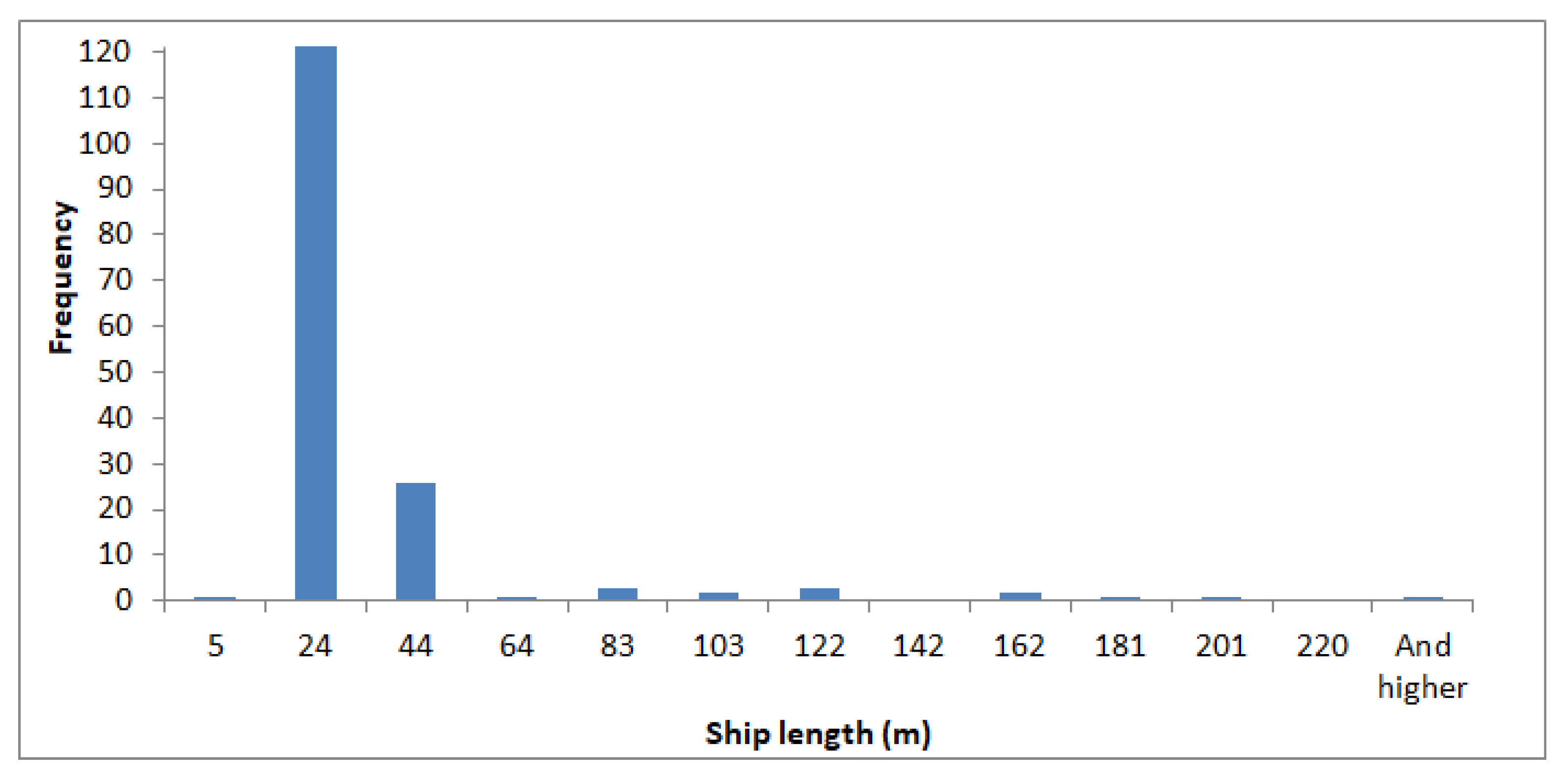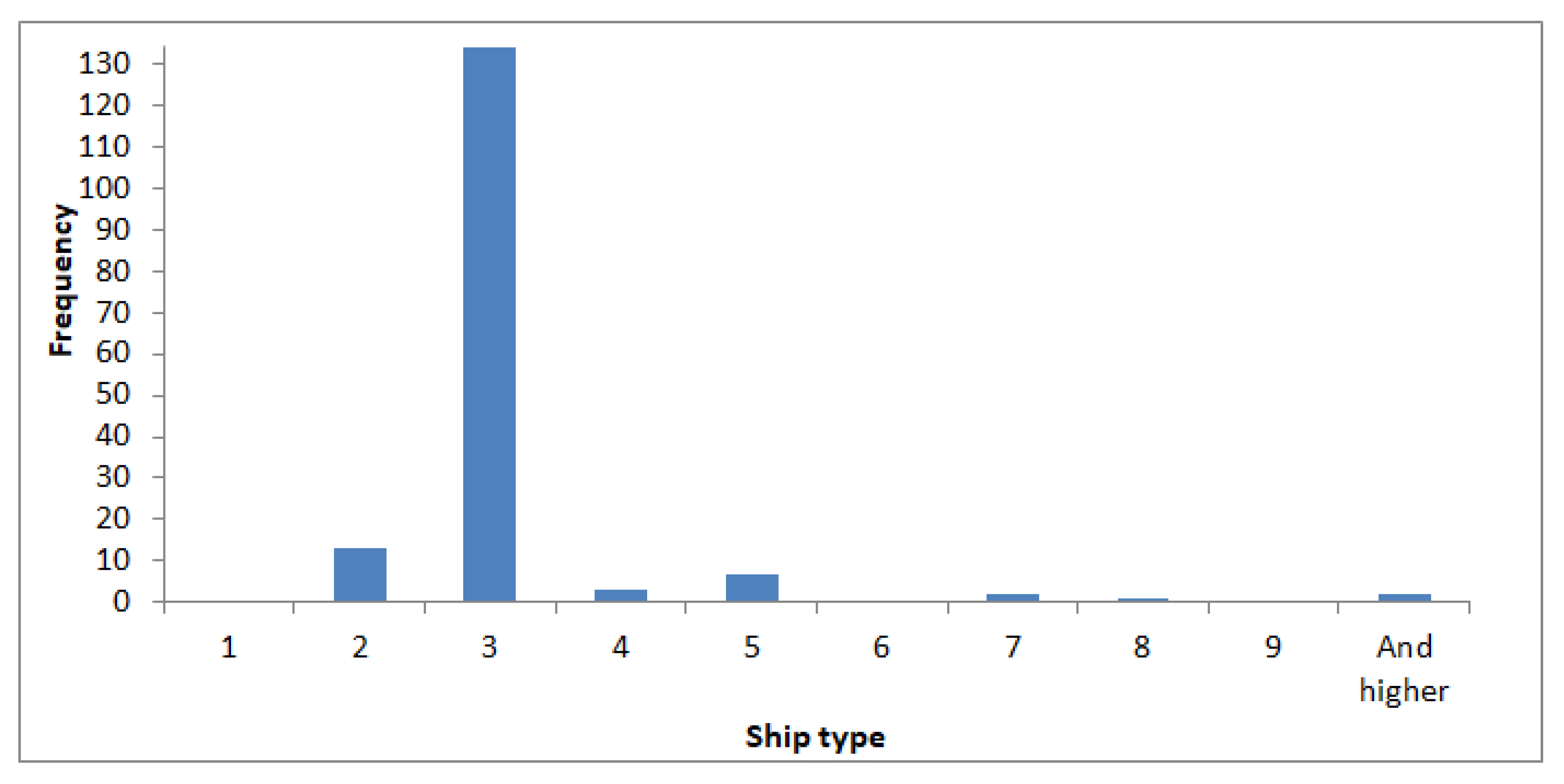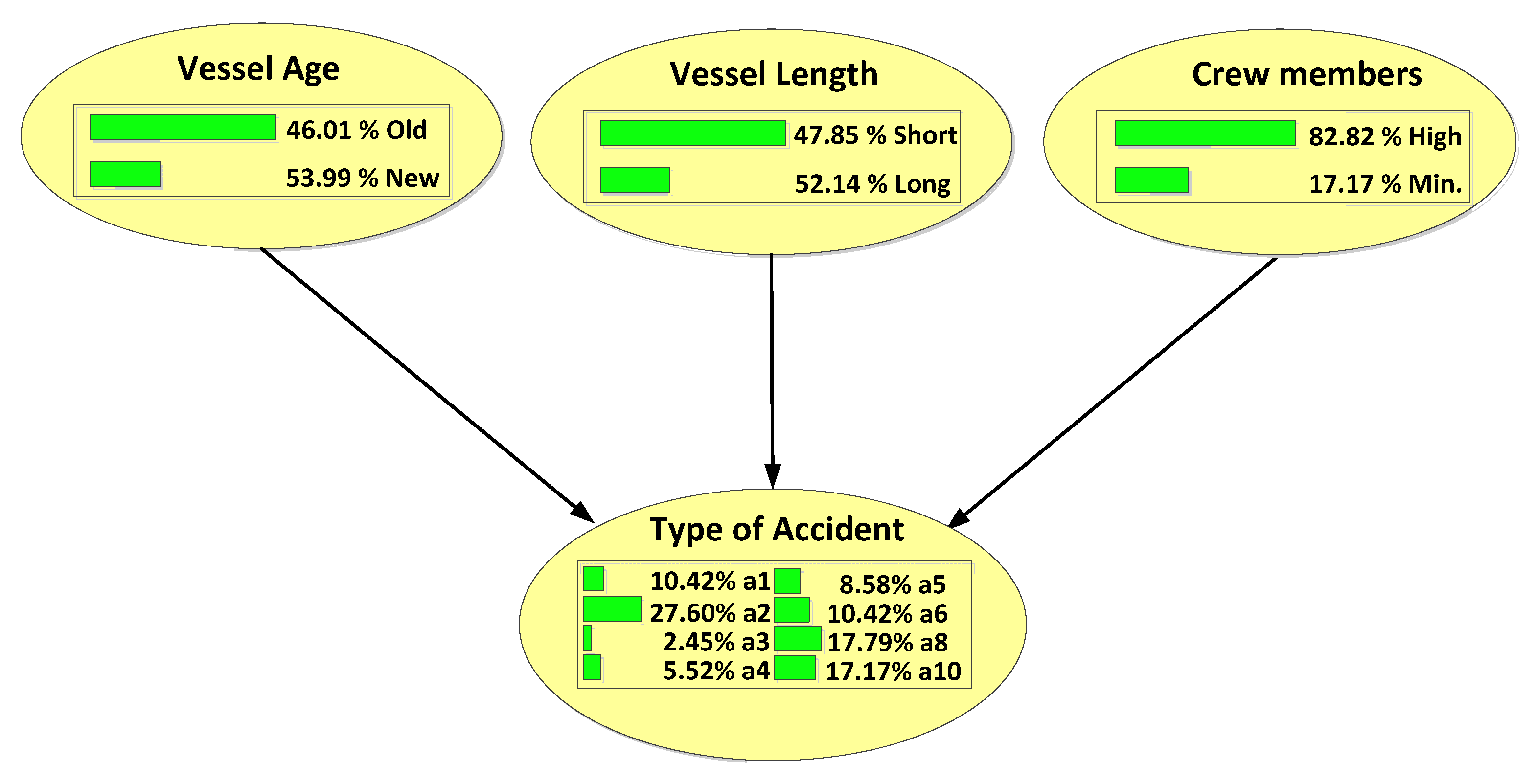1. Introduction
The traditional approach to studying or analyzing maritime safety is generally reactive rather than proactive. Hence, the importance of historic technical studies to try to foresee risk situations. Knowing which situations involve greater risk will in turn mean anticipating a possible accident. An accident theory is a collection of propositions to illustrate the principles that lead to accidents and an accident model is a simplified description of a system or process to help present the occurrence of accidents based on an accident theory [
1]. According to Perrow [
2], a normal accident is an intrinsic characteristic of any system. Given the characteristics of a system, multiple and unexpected interactions causing failures are inevitable. In this sense, the interactive complexity and the close characteristic coupling of the system inevitably produces an accident called “Normal Accident” or “System Accident”. These accidents are the ones that must be accepted as an acceptable risk.
According to a study of Allianz, shipping in the 21st century is now safer than ever [
3], probably due to a combination of factors both at technical level (technological advances), regulatory environment (international and national regulations), and fundamentally, to the influence of human factor (preparation and training). In this sense, it is in standard O-134: International Association of Marine Aids to Navigation and Lighthouse Authorities (IALA) Recommendation on the Risk Management Tool for Ports and Restricted Waterways (2009) [
4], where it addresses the IALA Waterway Risk Assessment Program (IWRAP) and Ports and Waterway Safety Assessment (PAWSA) tools.
The aim is to make available to the Member States aid for the measurement (quantitative and qualitative) of risk. The IWRAP MK2 tool, which IALA makes available to member states, calculate risk, based on the theory of Fujii and MacDuf (1974) [
5,
6] and presents results based on the possibility of an accident (although only collisions and groundings). Other researchers like Hollnagel and Goteman [
7], proposed the Functional Resonance Accident Model, FRAM in its English nomenclature (for Functional Resonance Accident Model). The idea suggests that accidents occur due to functional resonance within a system.
To reach this so complex objective a revision of the evolution of accidents analysis is needed. In this sense, previous research works [
8,
9] indicated that around 75 to 96% of maritime accidents are caused, at least in part, by some type of human error. Specifying that this human error contributes to between 89% and 96% of collisions, 75% of explosions, 79% of landings, and 75% of collisions. What is more, 56% of the approaches are caused by non-compliance or violation of Convention on the International Regulations for Preventing Collisions at Sea, COLREGs [
10,
11].
Despite the previous indications, no single model has the capability of being useful to satisfy all demands of the maritime industry at any moment. To solve this problem, different research works were done in the last decades. In this sense, in 2007, Ibn Awal et al. [
12], proposed a dynamic model for maritime accident focused on ship-to-ship collision, using two models of simulations, pre and post-accident, with the goal being to increase the maritime transport safety. Although it can be considered one of the accidents that has the worst consequences in the maritime world (for own ships, crewmembers, cargo, and the environment), the model does not include aspects so relevant as the waves or wind forces. This fact can give us an idea of the difficulty of proposing a model that can satisfy the huge number of variables that can be present in maritime transport.
In 2005, Liu et al. [
13] analyzed more than 100 marine incidents in order to improve the navigation safety system (frequencies and causes) of a specific area through the Gray Clustering Method (Gray system Theory). In this research work, it highlights the need of models that can be useful for areas where the maritime accidents/incidents database is incomplete or poor due to the unpredictability of maritime accidents, a fundamental characteristic of this Theory. Furthermore, a reliable database is not always available everywhere due to the opacity that the maritime industry sometimes presents when an accident happens. In consequence, it is shown how the knowledge of frequency and causes of maritime accidents can be very useful for shipping lines, underwriters and, in general, stakeholders in the maritime industry.
Once the main data are collected, they must be analyzed, and the probabilistic method is one of the most used in the maritime industry, in addition to simulation modelling and statistical analysis of data [
11]. In this sense, in 2009, Ulusçu, et al. [
14] developed a paradigmatic case such as the navigation risks in the Strait of Istanbul. In this study, the authors implement a safety risk analysis with a model based on probabilistic data. In the mathematical model proposed, factors that define situations and affecting the probability of accident are grouped in vessel attributes (type, length, age, flag, tugboat, and pilot assistance), and environmental attributes. Attributes also influence consequences; in this case, vessel attributes (type and length) and shore attributes (populations, property, and infrastructure).
After slicing the Strait in several legs and collecting local information from different sources, the risk is calculated in two-tier accident types, related to a set of instigators that may cause an accident (human error, steering, propulsion, communication, navigation, mechanical, or electrical failure). As a weak point, in part of a study, authors resort to the opinion of two experts (for comparative purposes) due to the lack of a solid database, which can help to clarify the final result. As an example, the plotting of the normal probability of residuals and residuals vs. predicted variable of pair is shown, focused mainly on the human error and its influence in the collision.
At the same time, at the time to define the variables related to accidents in vessels, it is of interest to center this study on fishing vessels due to the high number of accidents. In particular, recent review works based on journal articles and reports from the maritime authorities in Poland, United Kingdom, Norway, Iceland, Denmark, United States and Alaska, and Canada [
15] showed that these fishing vessels are still 50% higher at risk than on-shore workers, which is particularly high with respect to other types of vessels.
In addition, most of the previous works about fishing vessel accidents were centered on just one main variable, for instance, human factor [
16,
17,
18,
19]. Despite this, other variables were indicated as the main causes of fishing vessel accidents other than human error [
19,
20], e.g., weather conditions, operational status of the vessel, vessel location, seasons, and unsuitable fishing equipment [
21,
22,
23]. In particular, a statistical study of accidents in fishing vessels in the northeastern United States emphasized that the probabilities of accidents in fishing vessels increase with wind speed and with placement near the shore and in the winter season [
24]. In this same year, more research studies showed Marine Accident Investigation Branch (MAIB) as the better data source regarding fishing vessels accidents despite a certain tendency of under-reporting [
19]. In this work, a conclusion was obtained that confirms the previous comments; the risk of accidents on fishing vessels increases as vessel length decreases. What is more, a more recent study about fishing vessel accidents in the northeastern of the United States [
25] showed that the damage severity of accidents, defined in accordance with the Damage equation obtained by [
26], increases with loss of stability, sinking, daytime wind speed, vessel age, and distance to shore, in agreement with previous studies. At the same time, it was obtained that the damage severity of accidents on fishing vessels increases as vessel length decreases (inversely proportional).
At the time, to identify the variables related to accidents, different research works about the analysis of the variance (ANOVA) were done. In particular, a statistical analysis centered on questionnaires and posterior ANOVA and correlations analysis was done by [
16]. Its main results showed that there were clearly differentiated groups of age, vessel types, and occupation, among others. At the same time, in this work, there were assumptions of regression analysis such as linearity, normality, and multicollinearity, which were tested and found satisfactory. In consequence, it was possible to define the coefficient of the relation between related variables. From this relation it was concluded that the safety attitude is a fundamental parameter that depends on the previous experiences like people that sought medical attention (less positive attitude) and fishermen involved in accidents (positive attitude).
Once the main variables of these accidents were identified, there was a need to predict these accidents. In this sense, Mullai and Pulasson [
27] developed a conceptual model based on the principles of Grounded Theory and content analysis of empirical data, in order to explain and predict maritime accidents. For that purpose, a database containing the marine accidents classified by ship and variable was used. Most of the variables were non-metric and were grouped into 11 main categories (constructs). The design of variables was based on the European Statistics guidelines, the International Maritime Organization (IMO) investigations code, and the DAMA coding system (agreed in 1990 by the Scandinavian countries for the analysis of maritime accidents). In total, 87 variables were taken into account for designing the model, reduced to 11 “sets” or “constructs”, grouped as per their common properties. Therefore, the model carried out consisted of a multilevel model of 87 variables in complex relationships and permits one to obtain the correlations among a large number of independent variables as ship’s age, length, Gross Register Tonnage (GRT), and the number of persons on board.
Another paper related to human factors is based on the human factors index system of ship accidents to develop a multidimensional association rules algorithm by incorporating the Reason model and classic correlation rules algorithm [
28]. Other works are centered on human factor as the main cause of most serious maritime accidents [
29]. Authors use the model Human Factor Analysis and Classification System (HFACS) based on the Swiss Cheese model of human error, which had been developed to provide a methodological tool to investigating an accident in the aviation industry. The modification of this model had been implemented by the same authors to maritime accidents some years before, and for this paper, more than 150 real cases were handled. The model consists of two interrelated causal sequences: An active failure pathway and a latent failure pathway. Once coded, the causal factors are presented and divided (organizational influences, unsafe supervision, preconditions for unsafe acts and unsafe acts). Afterwards, the first-, second-, and third-tier results are depicted.
More recent works try to address the human factor and statistical procedure together to quantify the correlation path mode of the causal factor involved in marine accidents, making use of complex structural chains supported by HFACS together with the statistical method Structural Equation Modelling (SEM), used to quantitatively analyse the relationships among human factors in accidents [
30]. The paper is focused on the human factor because authors consider that in the shipping industry, despite having achieved a high level of safety from the point of view of equipment, human behavior still remains the cause of many maritime accidents. In the research, a Swiss Cheese model is also produced, and a novel method to analyze causal factors in the accidents is introduced with the help of SEM, due to the difficulty of doing the basic premises of path analysis (relationship among variables).
The measurement equation of SEM describes the relationship between the observed dependent variable and the latent independent variable. Structure equations describe the relationship between the latent variable. For the study, a database of 894 accident with the presence of human error as the cause was taken. Depending on the consequences, five levels were selected: Incidents, minor accidents, general accidents, major accidents, and serious accidents. The data were integrated into 16 major accident factors and path diagrams were carried out to check the accuracy and reliability of the model (relationships of observation or indicator variables).
Other studies are not centered on the human factor and develop their predictive procedures like a risk probabilistic model [
31] in order to evaluate the probability of a ship-grounding accident taking into account the causal factors. The database contained more than 200 accident and incident reports, although using only a single accident report for modelling has its own disadvantages. As in other papers, the grounding model was developed used the Human Factor Analysis and Classification System for Grounding (HFACS-Ground). In the model construction, in order to set up a qualitative causal model, the Bayesian Belief Network (BBN) modelling was used. The model can quantify the probability of grounding given a set of input parameters.
Finally, in recent works [
32], this same methodology of a chi square method and Bayesian networks were employed to be a help to estimate the occurrence of accidents when the main variables of the problem change.
In the present work, based on these previous research works and the need for in-depth study of these parameters, a real case study has been conducted analyzing more than 163 accidents in the Spanish Search and Rescue (SAR) sea regions in the time frame between 2008 and 2017. For this purpose, the official reports published by the Spanish Commission for Investigation of Maritime Accidents and Incidents (CIAIM) were taken into account [
33]. In particular, a procedure similar to previous research activities was employed but employing a more detailed analysis, replacing the VCH square method by the Analysis of Variance for each type of accident. This procedure will help to identify the more appropriate variable that allows us to identify the more probable type of accident in the particular sea region of the Spanish Search and Rescue (SAR). This initial study will be the base case to predict the occurrence of accidents when the main variables of the problem change based on future Bayesian networks studies.
